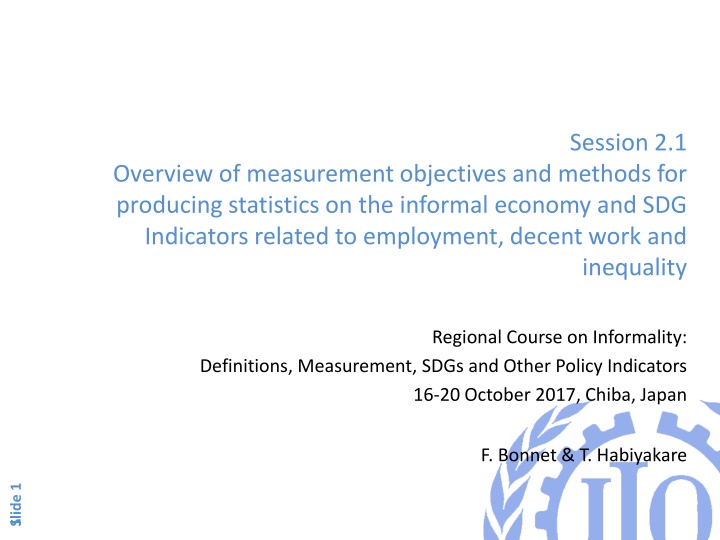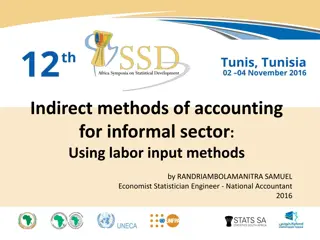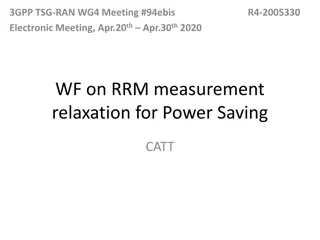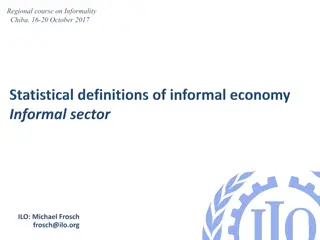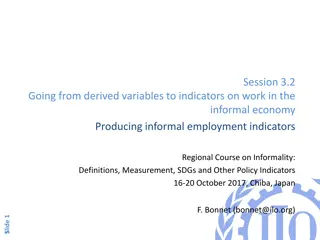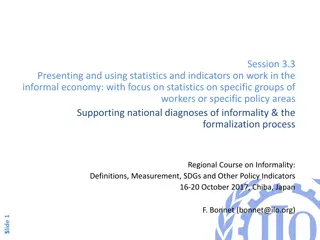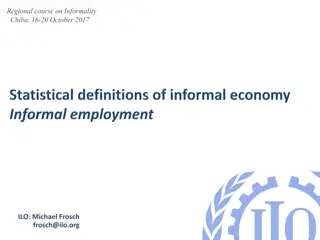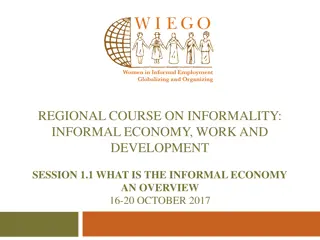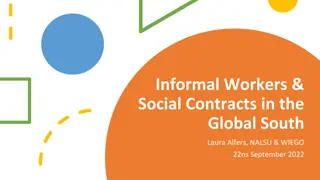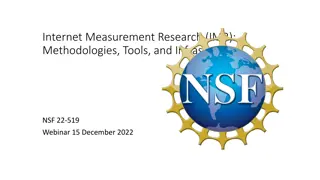Measurement Objectives and Methods for Producing Statistics on the Informal Economy
Gain an overview of measurement objectives and methods for producing statistics on the informal economy and SDG Indicators related to employment, decent work, and inequality. This session will cover essential aspects to effectively measure and analyze informal economic activities in the context of sustainable development goals.
Download Presentation

Please find below an Image/Link to download the presentation.
The content on the website is provided AS IS for your information and personal use only. It may not be sold, licensed, or shared on other websites without obtaining consent from the author.If you encounter any issues during the download, it is possible that the publisher has removed the file from their server.
You are allowed to download the files provided on this website for personal or commercial use, subject to the condition that they are used lawfully. All files are the property of their respective owners.
The content on the website is provided AS IS for your information and personal use only. It may not be sold, licensed, or shared on other websites without obtaining consent from the author.
E N D
Presentation Transcript
Objective of the session Session 2.1 Overview of measurement objectives and methods for producing statistics on the informal economy and SDG Indicators related to employment, decent work and inequality Regional Course on Informality: Definitions, Measurement, SDGs and Other Policy Indicators 16-20 October 2017, Chiba, Japan F. Bonnet & T. Habiyakare Slide 1 1
1. The context 2. The Recommendation R204: a tool that contributes to the achievement of SDG 8.3.1 3. SDGs 8.3.1 the state of play 4. Measurement objectives, main questions & preferred sources Content Slide 2 2
1. The context Slide 3 3
According to you what is the share of workers in informal employment In the world o <5% o 5-25% o 25-50% o 50-75% o 75-90% o >90% o >90% In the Americas o <5% o 5-25% o 25-50% o 50-75% o 75-90% o >90% o >90% o <5% o 5-25% o 25-50% o 50-75% o 75-90% o <5% o 5-25% o 25-50% o 50-75% o 75-90% 40% 61% In Asia & the Pacific o <5% o 5-25% o 25-50% o 50-75% o 75-90% o >90% o >90% In Africa o <5% o 5-25% o 25-50% o 50-75% o 75-90% o >90% o >90% In Europe o <5% o 5-25% o 25-50% o 50-75% o 75-90% o >90% o >90% o <5% o 5-25% o 25-50% o 50-75% o 75-90% o <5% o 5-25% o 25-50% o 50-75% o 75-90% o <5% o 5-25% o 25-50% o 50-75% o 75-90% 25% 68% 86% Slide 4
1. Size and composition of the informal economy % informal employment (estimates for 2016) Note: based on 118 countries representing 90 percent of global employment and estimated missing values. Estimates for 2016. Harmonized definition of informal employment (no registration or no complete set of accounts to define the informal sector and informal employment among own-account workers and employers; no social security gained through employment or, in case of missing, neither annual paid leave, nor paid sick leave to define informal employment among employees; all contributing family members are in informal employment). Limited number of countries for the Arab States, not displayed on this graph. Source: ILO calculations based on national household surveys Slide 6
1. The context More than 60% of the population in employment worldwide is in informal employment Nearly 70% in developing and emerging countries Still more than 50% when excluding agriculture Nearly 60% of non-agricultural employment in developing and emerging countries 1 Facts 2 Commitments Adoption of the Recommendation 204 concerning the transition from the informal to the formal economy First international standard to provide both a normative and a developmental framework focusing on the informal economy in its entirety and diversity A powerful tool to support the achievement of SDGs and in particular SDG 8.3.1 June 2015 September 2015 Adoption of the 2030 agenda for sustainable development 232 indicators including indicator 8.3.1: Proportion of informal employment in non-agricultural employment by sex September 2015 Slide 7
2. The R204: Objectives and how data & statistics can support it? Slide 8 8
2. Some highlights on the Preamble of R204 R204 recognizes that: the high incidence of the informal economy is a major challenge for the rights of workers and decent working conditions has a negative impact on enterprises, public revenues, government s scope of action, soundness of institutions and fair competition Most people enter in the informal economy not by choice Decent work deficits are more pronounced in the informal economy Transition is essential for inclusive development and decent work for all Workers and employers organizations play an important and active role to support transition to formality
2. R204 Threefold objectives To support the transition from the informal to the formal economy, R204 provides guidance to Members to: o Facilitate the transition of workers and economic units from the informal to the formal economy o Promote the creation, preservation and sustainability of enterprises and decent jobs in the formal economy o Prevent the informalization of formal economy jobs 3 objectives Recommendation 204 online: http://www.ilo.org/ilc/ILCSessions/104/texts-adopted/WCMS_377774/lang-- en/index.htm Slide 10
2. and some multiple forms of formalization processes Formalization processes can take different forms: + Prevention of informalization of formal employment Formalization of economic units: Existing economic units moving towards full formality or becoming fully formal: o Extending the scope of laws o Registration of economic units o increased compliance under commercial acts, with tax, labour and social security authorities Formalization of jobs: Existing jobs moving towards full formality or becoming fully formal. o Extending coverage of labour regulation; o Extending coverage of social security; o Establishment of a contract to reflect an existing employment relationship; Registration of unregistered employment relations Productive job creation in the formal economy Transitions that result in jobs and economic units being destroyed in the informal economy and created in the formal economy. o Most new entrants have access to employment in the formal economy o Increased formal employment intensity of growth + enabling factors (including reduction of decent work deficits in the IE) No formalization per se but conditions created to enable formalization e.g. extension of non-contributory social security; skills development; access to credit and to enterprise services; access to matkets, access to technology; etc ) Slide 11
2. R204 Policies to support the transition to formality Statistics will contribute as part of national diagnoses to define an appropriate set of policies to be identified and tailored to needs & capacities Policies that affect the environment/context pro-employment macroeconomic, trade, industrial, tax, sectoral and infrastructure policies aiming to promote formal employment, enhance productivity and facilitate structural transformation processes, etc. Policies that affect specific policy areas: Extension of social security; improved social dialogue and representation of workers in the informal economy; formalization of enterprises; education and skills policies, safety and health policies; etc. Will also Policies that target specific categories of economic units (e.g. formalization of MSEs), groups of workers (e.g. domestic work, self-employed), type of informality (e.g. undeclared work in formal enterprises). contribute to their monitoring Slide 12
2. R204 Some guiding principles with implications in terms of measurement Some guiding principles with implications in terms of measurement R204 Invites member states to take into account: the diversity of characteristics and needs of workers and economic units in the informal economy and the necessity to address such diversity with tailored approaches; the specific national circumstances the fulfilment of decent work for all the need to pay special attention to those who are especially vulnerable to the most serious decent work deficits in the informal economy (e.g. women, subsistence farmers, domestic workers, migrant workers, etc.); Slide 13 Contributes to the achievement of SDG 8.3.1 and goes beyond
2. R204 and statistics on informality (1) 2. R204 and statistics on informality (1) 1. 1. R204 provides a definition of R204 provides a definition of the informal economy the informal economy 2. 2. R204 includes a dedicated section on R204 includes a dedicated section on VIII. Data collection and monitoring VIII. Data collection and monitoring 2. For the purposes of this Recommendation, the term informal economy : (a) refers to all economic activities by workers and economic units that are in law or in practice not covered or insufficiently covered by formal arrangements; and VIII. Data collection and monitoring 36. Members should, in consultation with employers and workers organizations, on a regular basis: (a) where possible and as appropriate, collect, analyse and disseminate statistics disaggregated by sex, age, workplace, and other specific socio-economic characteristics on the size and composition of the informal economy, including the number of informal economic units, the number of workers employed and their sectors; and (b) monitor and evaluate the progress towards formalization. (b) does not cover illicit activities (I. Objectives and scope [ 2-5] in R204) Slide 14 Incl. SDG 8.3.1
2. R204 and statistics on informality (2) 2. R204 and statistics on informality (2) third, it calls for data & Statistics as a key element of national diagnoses and to monitor progress towards formalization third R204 calls for data and statistics to identify the nature and extent of the informal economy [para 6] as part of national diagnoses [para 8] 6. . given the diversity of the informal economy across member States, the competent authority should identify the nature and extent of the informal economy as described in this Recommendation, and its relationship to the formal economy. 8. Members should undertake a proper assessment and diagnostics of factors, characteristics, causes and circumstances of informality in the national context to inform the design and implementation of laws and regulations, policies and other measures aiming to facilitate the transition to the formal economy. Who are the workers in the informal economy? o Build consensus about national priorities o Clear link with policies: basis for o the adoption, review and enforcement of measures o monitoring progress towards formalization Analysis of some of the main drivers of informality => Not all quantifiable Slide 15 15
3. Decent Work in the 2030 Development Agenda & SDGs Indicator 8.3.1. Slide 16 16
3. Facilitating the transition to formality (R204) & SDGs Linked directly to SDG 8.3.1 Facilitating the transition to formality contributes to the achievement of SDG 8.3.1 Goal 8. Promote sustained, inclusive and sustainable economic growth, full and productive employment and decent work for all Target 8.3 Promote development-oriented policies that support productive activities, decent job creation, entrepreneurship, creativity and innovation, and encourage the formalization and growth of micro-, small- and medium-sized enterprises, including through access to financial services R204 objectives & contribution to the achievement of SDGs SDG 8.3.1 Share of informal employment in non- agriculture employment, by sex Slide 17
3. SDG Indicators Brief summary 17 goals, 169 targets and 232 unique indicators classified into three tiers: Tier I: an established methodology exists and data are already widely available Tier II: a methodology has been established but for which data are not easily available for all regions Tier III: an internationally agreed methodology has not yet been developed or it is not widely accepted or discussed and scarce info is available Slide 18 18
3. SDG Indicators Brief summary Responsible for reporting on the corresponding indicator at the global level The (ILO) is the sole custodian agency for 11 global SDG indicators joint custodian with other agencies for 3 indicators involved in 4 SDGs indicators some other twelve decent work related indicators or so are included in the global indicators framework, under the custodianship of partner agencies Under ILO custodian indicators (either as a sole custodian or jointly) Tier I: 7 Tier II: 4 Tier III: 3 employment Includes Indicator 8.3.1 on informal Slide 19 1 9
3. ILO as custodian agency What was shared with UNSD ? First submission by the ILO of SDG Indicator 8.3.1 to UNSD in February 2017 according to national definitions Data from 44 Member States Covering years from 2004 until 2015 417 value points Data are available both on ILO and UNSD Websites: www.ilo.org/ilostat https://unstats.un.org/sdgs/indicators/database/?indicator=8.3.1 Slide 20 20
3. R204 & SDGs Summary of Challenges Why? o Data on the different dimensions of IE are not collected o Issue about the national operational definition o Availability of data 1 o Comparability of available indicators Analysis, links to policy formulation & monitoring o Limited/no analysis of data available o Missing link between data collected & policies 2 o lack of analytical capacities? lack of time? lack of resources? Lack of interest? Lack of understanding? o Need to make more systematically the link with policies: Not just statistics but a basis for defining & monitoring policies . so this week Enhance the understanding of the concept of informality Improve data collection methods (questions to be included on the various criteria) Promote the adoption of operational definitions in line with international standards .. and as far as possible enhance comparability Enhance the analysis of data on informality Make the link with policies: going beyond the statistical dimension of SDG 8.3.1 & insist on expected outcomes linking it more systematically to R204 Slide 21
22 4. Measurement objectives, main questions & preferred sources Slide 22
4. Measurement objectives A. Main measurement objectives B. Different units of reference 1. Estimate the size and composition of the informal economy, including the number of informal economic units and the number of workers in informal employment 2. Identify some of the factors & causes of informality (quantifiable ones) 3. Assess the exposure to decent work deficits (informality and working conditions) & vulnerabilities 4. Monitor progress towards formalization: SDG 8.3.1 and specific policies 1. Informal employment, and employment in the informal sector (job/ worker based concept) 2. Informal economic units and contribution of informal sector economic units to GDP (enterprise based concept) taking into consideration The diversity of situations: different needs and policy responses depending on groups of workers and types of economic units The need to pay special attention to those who are especially vulnerable to the most serious decent work deficits Slide 23
4. Measurement objective 1 Estimate the size and composition of the informal economy Main questions Number & share of workers in informal employment / and number and share of workers employed in the informal sector informal jobs 1 - How many and who are those in informal employment? - Distribution of workers in informal employment by sex, age, location, employment status; occupations; sectors; etc. Who are the workers the most exposed to informality - Share of informal employment by sex; age; level of education, etc. - Share of informal employment by status in employment; by sector; by occupation Where does informal employment takes place: in informal sector enterprises; in formal sector enterprises, in households? - Session 3.2 - 2 Number and share of informal economic units & contribution to GDP Sessions 2.2, 3.4 - Nber and share of informal sector units & (Nber and share of workers engaged in informal sector units) How many and who are the entrepreneurs (own-account workers and employers) Economic features of informal economic units Gross output, Intermediate consumption; compensation of employees, Total value added (to estimate their contribution to GDP) - - Slide 24
4. Measurement objective 1 Estimate the size and composition of the informal economy Preferred sources Number & share of workers in informal employment / and number and share of workers employed in the informal sector informal jobs 1 Labour force survey Session 2.4 Session 2.6 Mixed modular survey Number and share of informal economic units & contribution to GDP: To measure value added of the informal sector & features of economic units 2 Session 2.5 Establishment survey* * When the country has carried out an Economic Census Mixed survey (otherwise) 3 To measure both employment and production with the same source Slide 25 Mixed modular survey
4. Measurement objective 2 Identify some of the factors & causes of informality Objective 2 Identify some of the factors & causes of informality (quantifiable ones) - Associated to the macro-economic context - What: Supposes a broader assessment of the labour market & macro economic situation - Information on the labour market at large: labour force participation; unemployment and under-employment; labour market structure (status in employment; sectors; occupations); employment by type of contracts, employment by size of enterprises... - Information about economic and employment growth and the composition of growth (GDP growth total and by sector; Job creation in the formal economy / in the informal economy) [Sources: LFS and national accounts] - Associated to micro level determinants of informality - What: facts ondiscrimination (gender; migrant; age); poverty; low level of education; low productivity; lack of access to finance; assets; lack of voice and representation - Sources: - LFS: basic socio-demo features for factors of discrimination (age; sex, migrant status; religion); education level; representation or workers, access to finance; labour income, etc. - Household income and expenditure surveys: poverty issues; household structure - Establishment surveys, Informal sector surveys; Enterprises census: main constraints to formalization of economic units; low productivity, etc. Session 3.3 Slide 26
4. Measurement objective 3 Assess the exposure to decent work deficits Assess the exposure to decent work deficits (informality and working conditions) Objective 3 - Exposure to decent work deficits - What (examples, depends on data availability in surveys): - Hours of work (exposure to excessive hours without due compensation; very short hours of work, time related under-employment and associated working poverty) - Health and safety issues in the work place: exposure, prevention & protection - Duration and stability of employment - Labour income: nature; level, stability and predictability - Representation of workers (unionization), affiliation to professional organizations - Social security coverage (employment related) & alternative coverage through non-contributory schemes - etc - Source: - Labour force surveys (mainly) & household income & expenditure surveys Session 3.3 Slide 27
4. Measurement objectives 4 Monitoring of progress towards formalization Objective 4 Monitoring of progress towards formalization 1. Monitoring SDG 8.3.1 & related indicators about the size & composition of the IE 2. Monitoring the implementation of specific measures: - by policy area, such as - Formalization of enterprises (eg. Percentage of registered enterprises) - Sources: Enterprise surveys and censuses; labour force surveys (to some extent) and administrative sources (e.g. registration of economic units under different forms) - Extension of social security: employment related & delinked from employment; for employees as well as for the self-employed (proportion of employed contributing for a given social security risk/ contingency; proportion of employed covered for non- contributory benefits for a given risk/ contingency) - Sources: Surveys (labour force surveys, household income and expenditure surveys); administrative sources (from social security institutions) - for particular groups of workers such as: - Domestic workers, home-based workers, street vendors, etc. - Undeclared work - Sources: surveys (labour force) and administrative sources (eg. labour inspection; employment agency) Slide 28
Goal 1 End poverty in all its forms everywhere Goal 2 End hunger, achieve food security and improved nutrition and promote sustainable agriculture Goal 3 Ensure healthy lives and promote well-being for all at all ages Goal 4 Ensure inclusive and equitable quality education and promote lifelong learning opportunities for all List of Sustainable Development Goals Goal 5 Achieve gender equality and empower all women and girls Goal 6 Ensure availability and sustainable management of water and sanitation for all Goal 7 Ensure access to affordable, reliable, sustainable and modern energy for all Promote sustained, inclusive and sustainable economic growth, full and productive employment and decent work for all Goal 8 Goal 9 Build resilient infrastructure, promote inclusive and sustainable industrialization and foster innovation Goal 10 Reduce inequality within and among countries Goal 11 Make cities and human settlements inclusive, safe, resilient and sustainable Goal 12 Ensure sustainable consumption and production patterns Goal 13 Take urgent action to combat climate change and its impacts Goal 14 Conserve and sustainably use the oceans, seas and marine resources for sustainable development Protect, restore and promote sustainable use of terrestrial ecosystems, sustainably manage forests, combat desertification, and halt and reverse land degradation and halt biodiversity loss Goal 15 Promote peaceful and inclusive societies for sustainable development, provide access to justice for all and build effective, accountable and inclusive institutions at all levels Goal 16 Strengthen the means of implementation and revitalize the global partnership for sustainable development Goal 17 30
Custodian agency/ies WB Partner agency/ies ILO SDG indicators under ILO custodianship or with ILO involvement SDGs Indicators under ILO custodianship Tier 1.1.1 Proportion of population below the international poverty line, by sex, age, employment status and geographical location (urban/rural) 1.3.1 Proportion of population covered by social protection floors/systems by sex, distinguishing children, unemployed persons, older persons, persons with disabilities, pregnant women, newborns, work-injury victims and the poor and the vulnerable 1.a.2 Proportion of total government spending on essential services (education, health and social protection) 4.3.1 Participation rate of youth and adults in formal and non-formal education and training in the previous 12 months, by sex 5.5.2 Proportion of women in managerial positions 8.2.1 Annual growth rate of real GDP per employed person 8.3.1 Proportion of informal employment in non-agriculture employment, by sex 8.5.1 Average hourly earnings of female and male employees, by occupation, age and persons with disabilities 8.5.2 Unemployment rate, by sex, age and persons with disabilities 8.6.1 Proportion of youth (aged 15-24 years) not in education, employment or training 8.7.1 Proportion & nb of children aged 5-17 years engaged in child labour, by sex & age 8.8.1 Frequency rates of fatal & non-fatal occupational injuries, by sex & migrant status 8.8.2 Level of national compliance of labour rights (freedom of association and collective bargaining) based on International Labour Organization (ILO) textual sources and national legislation, by sex and migrant status 8.b.1 Existence of a developed and operationalized national strategy for youth employment, as a distinct strategy or as part of a national employment strategy 10.4.1 Labour share of GDP, comprising wages and social protection transfers 10.7.1 Recruitment cost borne by employee as a proportion of yearly income earned in country of destination 14.c.1 Number of countries making progress in ratifying, accepting and implementing through legal, policy and institutional frameworks, ocean-related instruments that implement international law, as reflected in the United Nation Convention on the Law of the Sea, for the conservation and sustainable use of the oceans and their resources 16.10.1 Number of verified cases of killing, kidnapping, enforced disappearance, arbitrary detention and torture of journalists, associated media personnel, trade unionists and human rights advocates in the previous 12 months I ILO WB II Under discussion (ILO, UNESCO- UIS, WHO) UNESCO-UIS II OECD, ILO, EUROSTAT II ILO ILO ILO ILO I I WB, UNSD II II ILO ILO ILO and UNICEF ILO ILO I I I I III ILO WB, OECD III ILO ILO and WB IMF I III UN-DOALOS, FAO, UNEP, ILO, other UN Oceans agencies III OHCHR ILO, UNESCO- UIS III 31
3. Transition to formality & SDGs Expected associated outcomes and links to other SDGs (1) What are the expected outcomes of the transition to formality (incl. a reduction of decent work deficits in the IE? SDGs concerned What do we know about the informal economy? Poverty | 1(1.1- 1.4) Inequality | 10(10.1- 10.4) Decent work deficits| 8(8.3, 8.5, 8.8) Informal economies, while heterogeneous, are typically characterized by a high incidence of poverty, inequality, vulnerability and severe, widespread decent work deficits. Women are not necessarily more exposed but when in informal employment, they tend to be in the most vulnerable segments of the IE Gender inequality| 5(5.1; 5.4; 5a; 5c) the high incidence of the informal economy has a negative impact on enterprises, public revenues, government s scope of action, soundness of institutions and fair competition Workers and employers organizations play an important and active role to support transition to formality Productive enterprises; effective institutions | 8(8.3), 10(10.4), 16 (16.6) Slide 32 Labour rights | 8(8.8)
3. SDGs and R204 results & associated outcomes (1) What are the expected outcomes of the transition to formality (incl. a reduction of decent work deficits in the IE? SDGs concerned The long term process of facilitating the transition to formality requires to address the root causes of informality . Productive growth | 8 (8.3 & 8.1) The economic context (e.g. inability to create formal jobs); Governance | 16(16.6) Poverty | 1(1.3) Labour rights | 8(8.8) Education | 4(All but 4.4) Equal rights to economic resources | 1(All but 1.4); 5(5.1 and 5a) & 10 (10.2-10.3) the legal, regulatory and policy frameworks (inadequate or lacking, lack of transparency, lack of adequate social benefits to secure income or inappropriate modalities to comply, etc.) Some micro level determinants: low level of education, discrimination, low productivity, poverty, lack of access to eco resources, to property, to financial & other business services; to markets (incl. public market), lack of voice Slide 33 Productivity | 8(8,2; 8,5 )
